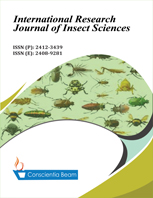High-Sensitivity Testing of Effectiveness of Citrus Limon, Vitis Vinifera and Citrus Sinensis in the Postharvest Control of Callosobruchus Maculatus Fabricius (Coleoptera: Chrysomelidae) Infestation of Cowpea Seeds
DOI:
https://doi.org/10.18488/journal.106.2020.51.1.6Abstract
Traditional control tactics are commonly employed against stored-product insects and mites in developing countries. Therefore, at economically justified dose of 1.0% (w/w), the biological activities of dry peel powders of three citrus species were evaluated in laboratory conditions (30oC, 77.8% r.h.) against Callosobruchus maculatus Fabricius (Coleoptera: Chrysomelidae) infesting cowpea, Vigna unguiculata (L.) Walp seeds in storage. The dry peel powder of the three citrus fruit species (the lemon, Citrus limon; the common grape vine, Vitis vinifera; sweet orange, Citrus sinensis) had contact toxicity on the C. maculatus insect pest and affected its biological traits in a trial that used ten varieties of cowpea. Citrus limon caused the highest adult mortality at 24 h high-sensitivity exposure time and this differed significantly from mortalities caused by the other citrus species. The same results were obtained for oviposition, adult emergence and seed damage. The pooled mean toxic effect of C. limon on the store-product pest was comparable to cypermethrin standard insecticide in 24 h. Trials using pure compounds have shown that limonene is responsible for C. limon toxicity. Powders of the citrus materials were effective in this order lemon > grape vine > sweet orange; the effect reduced by 50% across the test materials. Citrus limon dry peel powder should be used solely to protect seeds of cowpea in stores against infestation and damage by C. maculatus. It should also be incorporated into the integrated pest management system for the control of C. maculatus infestation in stored cowpea.

